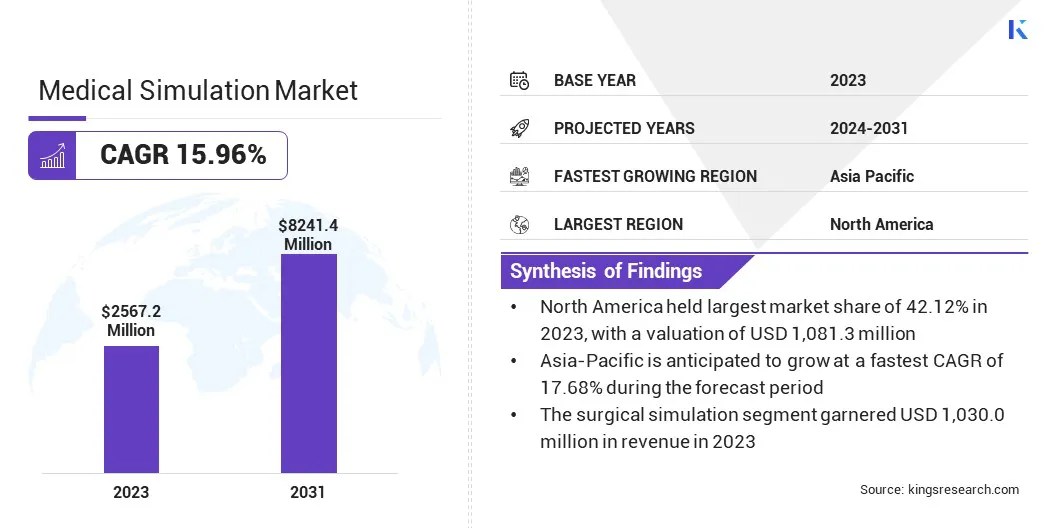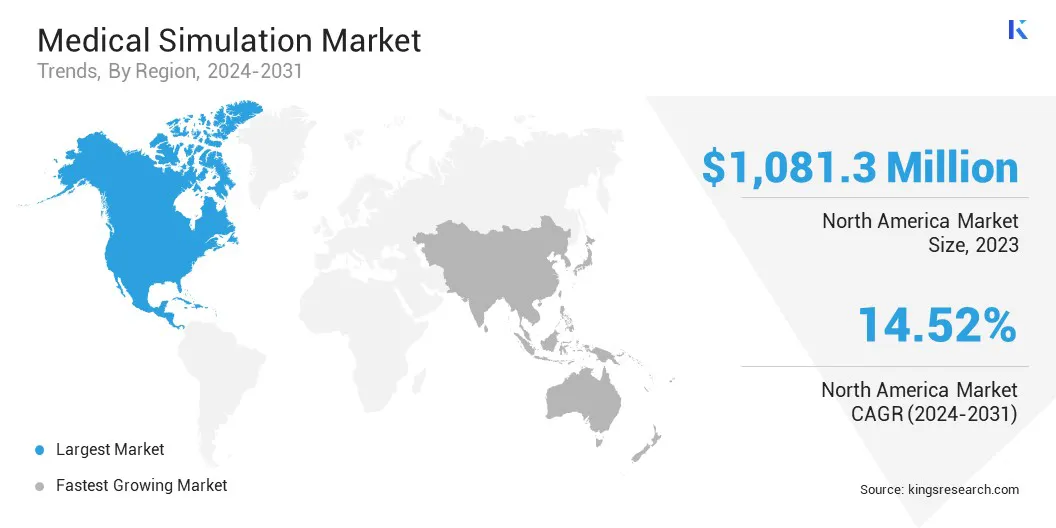Market Definition
The market involves technologies that replicate real-life medical scenarios for training, education, and skill development. It includes software, hardware, and virtual platforms used by healthcare professionals to practice procedures, diagnosis, and patient care without risk.
This market is growing due to advancements in technology, increasing demand for skilled medical professionals, and the need for safer, more efficient training methods.
Medical Simulation Market Overview
Global medical simulation market size was USD 2,567.2 million in 2023, which is estimated to be valued at USD 2,923.8 million in 2024 and reach USD 8,241.4 million by 2031, growing at a CAGR of 15.96% from 2024 to 2031.
The increasing demand for skilled healthcare professionals is driving the adoption of simulation-based training. As medical procedures become more complex, institutions increasingly utilize simulations to enhance workforce training, ensuring proficiency in delivering high-quality patient care.
Major companies operating in the medical simulation industry are Laerdal Medical, Simulab Corporation, Limbs & Things Inc., Simulaids, Kyoto Kagaku Co., Ltd, Gaumard Scientific, Mentice, Surgical Science Sweden AB, Intelligent Ultrasound Simulation (MedaPhor Ltd), Operative Experience, Inc, Cardionics Inc (3B Scientific), VirtaMed AG, IngMar Medical, Tru Corp, HRV Simulation, and others.
The market is evolving rapidly as healthcare systems prioritize advanced training solutions. It is characterized by the integration of innovative technologies to enhance learning experiences for medical professionals. Simulation enhaces skill development and patient safety by providing a realistic environment for procedural practice and informed decision-making.
Institutions are increasingly adopting these tools, acknowledging their value in reducing errors, enhancing competencies, and ensuring a higher standard of care. The market reflects a broader shift toward more efficient, effective healthcare training and education.
- In July 2024, Sri Ramachandra Institute of Higher Education and Research (SRIHER), in collaboration with MediSim VR, established a VR laboratory to enhance medical training. This facility provides immersive, interactive medical training, enabling students to effectively transition from theoretical learning to practical application in a controlled environment.

Key Highlights:
- The medical simulation industry size was recorded at USD 2,567.2 million in 2023.
- The market is projected to grow at a CAGR of 15.96% from 2024 to 2031.
- North America held a share of 42.12% in 2023, valued at USD 1,081.3 million.
- The healthcare anatomical models segment garnered USD 793.0 million in revenue in 2023.
- The hospitals segment is expected to reach USD 2,615.2 million by 2031.
- The patient management simulation segment is projected to grow at a CAGR of 18.21% over the forecast period.
- The procedure rehearsal technology segment is anticipated to capture a share 39.60% by 2031
- Asia Pacific is anticipated to grow at a CAGR of 17.68% through the projection period.
Market Driver
"Advancements in Technology"
Advancements in technology, particularly in virtual reality (VR), augmented reality (AR), and artificial intelligence (AI), are fueling the growth of the medical simulation market. These innovations create immersive, interactive environments that accurately simulate real-life medical scenario.
VR and AR enable students and professionals to practice complex procedures in a risk-free setting, while AI enhances decision-making and performance feedback. These technologies offer more effective, engaging, and comprehensive training experiences, revolutionizing medical education and skill development.
- In May 2024, Accenture, through Accenture Ventures, strategically invested in Turbine, a predictive simulation company. Turbine’s Simulated Cell platform leverages AI and machine learning to models molecular interactions and simulate human biology, enabling virtual experiments. This technology is advancing drug discovery by revealing hidden biological insights and offering solutions to complex diseases.
Market Challenge
"Shortage of Skilled Instructors"
A significant challenge in the medical simulation market is the shortage of skilled instructors who are both experts in medical content and proficient in using advanced simulation tools. Many institutions struggle to find and train instructors capable of effectively integrate these technologies into their teaching methods.
This challenge can be addressed through the development of specialized training programs for educators and medical students, ensuring they gain both medical expertise and technical skills in simulation platforms. Collaboration between simulation providers and educational institutions can further support this effort.
- In July 2024, MediSim VR launched a VR training lab at KD Hospital in Gujarat, India, advancing healthcare worker upskilling. The lab, equipped with XR hardware and software, offers immersive learning to enhance professional readiness and confidence.
Market Trend
"Increased Investment in Healthcare Simulation Technology"
A key trend in the medical simulation market is the growing collaboration between simulation companies and government or military organizations to enhance training for healthcare professionals. These partnerships are fostering the development of advanced simulation technologies, such as VR and AR, to improve specialized medical training.
By integrating immersive training methods, these collaborations aim to address the need for more accessible, effective, and realistic healthcare education, particularly for professionals in remote or high-pressure environments, thereby enhancing overall training outcomes and readiness.
- In December 2024, SimX received a USD 1.25 million Phase II STTR grant from AFWERX to enhance its Virtual Reality Medical Simulation System (VRMSS). The project, in collaboration with USF Health CAMLS, seeks to improve perioperative training for military healthcare teams.
Medical Simulation Market Report Snapshot
| Segmentation |
Details |
| By Product & Services |
Healthcare Anatomical Models, Web Based Simulators, Healthcare Simulation Software, Simulation Training Services |
| By End-Use |
Academic Institutes, Hospitals, Military Organizations, Research |
| By Application |
Surgical Simulation, Endoscopic Simulation, Patient Management Simulation, Procedural Training |
| By Type |
Virtual Patient Simulation, 3D Printing, Procedure Rehearsal Technology |
| By Region |
North America: U.S., Canada, Mexico |
| Europe: France, U.K., Spain, Germany, Italy, Russia, Rest of Europe |
| Asia-Pacific: China, Japan, India, Australia, ASEAN, South Korea, Rest of Asia-Pacific |
| Middle East & Africa: Turkey, UAE, Saudi Arabia, South Africa, Rest of Middle East & Africa |
| South America: Brazil, Argentina, Rest of South America |
Market Segmentation:
- By Product & Services (Healthcare Anatomical Models, Web Based Simulators, Healthcare Simulation Software, and Simulation Training Services): The healthcare anatomical models segment earned USD 793.0 million in 2023 due to increasing demand for realistic, interactive models in medical education and training.
- By End-Use (Academic Institutes, Hospitals, Military Organizations, and Research): The academic institutes segment held a share of 31.88% in 2023, fueled by the widespread integration of simulation-based training into medical school curricula for enhanced skill development.
- By Application (Surgical Simulation, Endoscopic Simulation, Patient Management Simulation, and Procedural Training): The surgical simulation segment is projected to reach USD 2,803.5 million by 2031, largely attributed to the rising complexity of surgeries and the need for precision training to reduce errors and improve outcomes.
- By Type (Virtual Patient Simulation, 3D Printing, and Procedure Rehearsal Technology): The virtual patient simulation segment is anticipated to register a CAGR of 17.89% over the forecast period, mainly propelled by its ability to provide realistic, risk-free scenarios for training medical professionals across various specialties.
Medical Simulation Market Regional Analysis
Based on region, the global market has been classified into North America, Europe, Asia Pacific, Middle East & Africa, and Latin America.

North America medical simulation market accounted for a notable share of around 42.12% in 2023, valued at USD 1,081.3 million. This dominance is reinforced by significant investments in healthcare infrastructure, advanced technologies, and educational institutions. The presence of leading simulation technology providers, along with strong government support for healthcare training programs, further fuels this growth.
Emphasis on patient safety, error reduction, continuous professional development, and the widespread adoption of virtual reality (VR) and augmented reality (AR) in medical education further support its dominance.
- In October 2024, Dassault Systèmes, in collaboration with the FDA, introduced the first guide for medical device industry virtual twins. This development represents a significant milestone in regulatory advancement and patient safety, demonstrating the region's leadership in leveraging cutting-edge technologies to accelerate innovation and improve healthcare outcomes.
Asia Pacific medical simulation industry is set to grow at a robust CAGR of 17.68% over the forecast period.This growth is mainly fueled by improvements in healthcare access, expanding medical education initiatives, and the increasing need for cost-effective training solutions.
As countries such as China, India, and Japan modernize their healthcare systems, the need for advanced simulation technologies to enhance clinical skill development increases. Additionally, collaborations between governments, educational institutions, and simulation technology providers are boosting the rapid adoption of medical simulation tools, fostering regional market growth.
Region’s Regulatory Framework Also Plays a Significant Role in Shaping the Market
- In the U.S. the FDA has published guidance on “Assessing the Credibility of Computational Modeling and Simulation in Medical Device Submissions.” This guidance provides a risk-informed framework to assess the credibility of computational modeling and simulation, which can be used in various medical device applications, including in silico device testing or embedded software.
- In the U.S., the Association of American Medical Colleges (AAMC) is a not-for-profit organization dedicated to advancing health through medical education, health care, medical research, and community collaborations.
- In the EU, manufacturers can place a CE (Conformité Européenne) mark on a medical device once it has passed a conformity assessment. The conformity assessment usually involves an audit of the manufacturer's quality system and, depending on the type of device, a review of technical documentation regarding its safety and performance.
Competitive Landscape
The medical simulation market is characterized by a large number of participants, including both established corporations and emerging players. Prominant companies are actively focusing on the introduction of innovative medical simulation products to enhance healthcare training.
The integration of technologies such as virtual reality and augmented reality into simulation systems is improving the realism of medical procedures, making training more effective, accessible, and cost-efficient for healthcare professionals worldwide.
- In March 2024, Wolters Kluwer Health launched two resources to support nursing education: a book titled "A Practical Guide for Nurse Practitioner Faculty Using Simulation in Competency-Based Education" and an upcoming webinar on simulation in nurse practitioner education, focused on enhancing clinical skills and competency-based outcomes.
List of Key Companies in Medical Simulation Market:
- Laerdal Medical
- Simulab Corporation
- Limbs & Things Inc.
- Simulaids
- Kyoto Kagaku Co., Ltd
- Gaumard Scientific
- Mentice
- Surgical Science Sweden AB
- Intelligent Ultrasound Simulation (MedaPhor Ltd)
- Operative Experience, Inc
- Cardionics Inc (3B Scientific)
- VirtaMed AG
- IngMar Medical
- Tru Corp
- HRV Simulation
Recent Developments (Partnership/Launch/Funding/Investment)
- In January 2024, Laerdal Medical entered into an exclusive global distribution agreement with SIMCharacters, an Austrian neonatal simulation innovator. This partnership aims to enhance neonatal care training using SIMCharacters’ simulators, "Paul" and "Emily," expanding Laerdal’s global presence and simulation capabilities.
- In January 2024, CAE Healthcare teamed up with SimHawk to enhance ultrasound training by merging SimHawk's motion-based learning with CAE’s Vimedix manikin-based simulation. This collaboration offers a flexible, comprehensive approach to ultrasound education, addressing healthcare staffing challenges while improving training efficiency.
- In June 2023, Wolters Kluwer Health and Laerdal Medical launched vrClinicals for Nursing, a VR-based platform designed to address gaps in nursing education. It immerses students in multi-patient scenarios to boost clinical judgment and prepare them for real-life healthcare environments and the NCLEX exam.
- In August 2024, HCA Healthcare donated USD 500,000 to Nova Southeastern University to establish a clinical simulation lab for its new nurse anesthesiology program. This donation supports HCA’s broader USD 10 million commitment to strengthen healthcare education and address workforce shortages at colleges and universities.
- In April 2024, FUJIFILM Healthcare Europe GmbH launched EndoGel, a training simulator for Endoscopic Submucosal Dissection (ESD) and Peroral Endoscopic Myotomy (POEM) procedures. This innovation enhances endoscopy professionals' skills, ensuring improvedr patient outcomes through realistic simulation and cost-effective training.
- In January 2024, Accenture Ventures invested in QuantHealth, an AI-driven clinical trial design company. QuantHealth’s simulation platform enables faster, cost-effective drug development by predicting trial outcomes, optimizing protocols, and reducing risks, significantly improving efficiency in clinical trials and accelerating patient treatment options.


